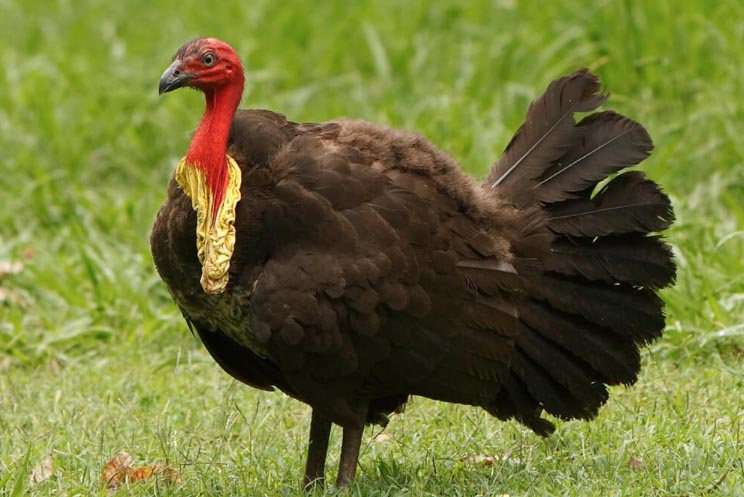Brush Turkey

Facts about creatures
- Home
- Animal Classification
- Animal Habitats
- Amphibians
- Arthropods
- Bats
- Birds
- Carnivorans
- Cetaceans
- Chordates
- Crustaceans
- Dinosaurs
- Diprotodonts
- Elephants
- Fish
- Golden Mole
- Insects
- Lagomorphs
- Mammals
- Mammal Teeth
- Marsupial Mole
- Metamorphosis
- Mollusks
- Primates
- Reptiles
- Rodents
- Ruminants
- Soricomorphans
- Tenrec
- Tetrapods
- Vertebrates
Brush Turkey
The brush turkey (Alectura lathami), is an Australian galliform.
It is also known as the bush turkey or scrub turkey.
The brush turkey is the largest living megapode. It ranges from about 2 to 2 ½ feet long and has a wingspan of almost 3 feet.
Male brush turkeys build large nest mounds in which heat from fermenting plant matter is used to keep the eggs warm.

Appearance
The brush turkey has mostly black plumage. It has a red face, a yellow ring around its neck, light brown legs and a smattering of white feathers on its underside.
There are no feathers on the brush turkey’s head.
The brush turkey’s tail is shaped like a fan.
On the brush turkey’s neck, there is a wattle, or fleshy growth. This may be yellow or pale blue.
Behavior
The brush turkey lives in forests and scrublands, and roosts in trees.
It will fly if it is alarmed.
The diet of the brush turkey includes insects, seeds and fruits that it uncovers in leaf litter. Sometimes brush turkeys will eat ripened fruits on tree branches.
Brush turkeys are sometimes considered pests.
They pull up garden plants to use in their nests, and they may steal food scraps from picnic tables or from garbage.
Breeding and Nest-Building
The male brush turkey builds a large nest mound of earth, leaves and other plant materials.
A nest mound can be up to 5 feet high and 13 feet across. It can contain the eggs of several females.
Females lay eggs between September and March (spring to early autumn in Australia).
Each egg is laid separately. Individual eggs may be laid weeks or months apart.
The female picks a nest mound in which to lay each egg, choosing from mounds built by different males.
She will copulate with the male who built the mound she chose.
Once eggs are laid, the heat from the fermenting vegetable matter in the nest incubates them.
The male regulates the temperature of the mound by adding and removing material from it.
He uses his beak to check the mound’s temperature.
The temperature is maintained at between about 91 and 95 degrees Fahrenheit.
If the temperature is close to the lower end of this range, more males will be born. If it is close to the higher end of the range, more females will be born.
When the chicks are born – about 1 ½ months after the eggs are laid – they are independent and do not rely on parental care. They can fly a few hours after they hatch.